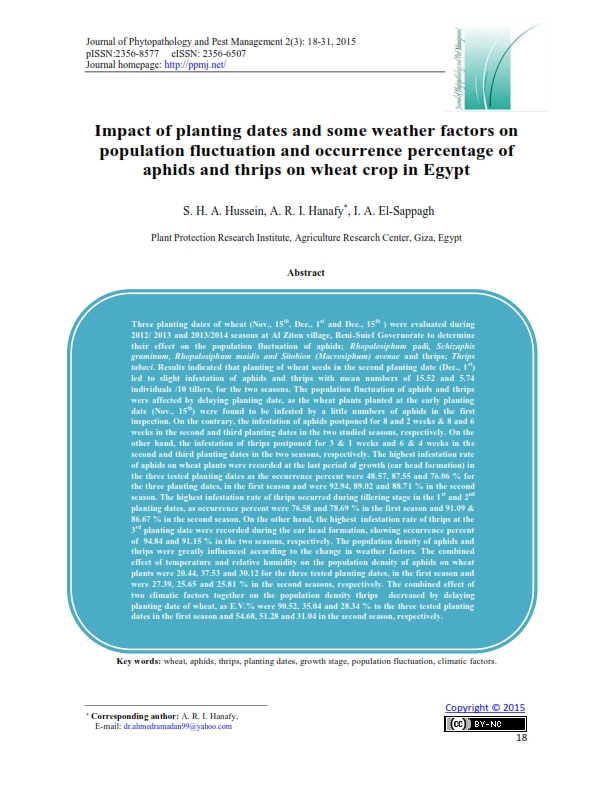Impact of planting dates and some weather factors on population fluctuation and occurrence percentage of aphids and thrips on wheat crop in Egypt
Keywords:
wheat, aphids, thrips, planting dates, growth stage, population fluctuation, climatic factors.Abstract
Three planting dates of wheat (Nov., 15th, Dec., 1st and Dec., 15th ) were evaluated during 2012/ 2013 and 2013/2014 seasons at Al Ziton village, Beni-Suief Governorate to determine their effect on the population fluctuation of aphids; Rhopalosiphum padi, Schizaphis graminum, Rhopalosiphum maidis and Sitobion (Macrosiphum) avenae and thrips; Thrips tabaci. Results indicated that planting of wheat seeds in the second planting date (Dec., 1st) led to slight infestation of aphids and thrips with mean numbers of 15.52 and 5.74 individuals /10 tillers, for the two seasons. The population fluctuation of aphids and thrips were affected by delaying planting date, as the wheat plants planted at the early planting date (Nov., 15th) were found to be infested by a little numbers of aphids in the first inspection. On the contrary, the infestation of aphids postponed for 8 and 2 weeks & 8 and 6 weeks in the second and third planting dates in the two studied seasons, respectively. On the other hand, the infestation of thrips postponed for 3 & 1 weeks and 6 & 4 weeks in the second and third planting dates in the two seasons, respectively. The highest infestation rate of aphids on wheat plants were recorded at the last period of growth (ear head formation) in the three tested planting dates as the occurrence percent were 48.57, 87.55 and 76.06 % for the three planting dates, in the first season and were 92.94, 89.02 and 88.71 % in the second season. The highest infestation rate of thrips occurred during tillering stage in the 1st and 2nd planting dates, as occurrence percent were 76.58 and 78.69 % in the first season and 91.09 & 86.67 % in the second season. On the other hand, the highest infestation rate of thrips at the 3rd planting date were recorded during the ear head formation, showing occurrence percent of 94.84 and 91.15 % in the two seasons, respectively. The population density of aphids and thrips were greatly influenced according to the change in weather factors. The combined effect of temperature and relative humidity on the population density of aphids on wheat plants were 20.44, 37.53 and 30.12 for the three tested planting dates, in the first season and were 27.39, 25.65 and 25.81 % in the second seasons, respectively. The combined effect of two climatic factors together on the population density thrips  decreased by delaying planting date of wheat, as E.V.% were 90.52, 35.04 and 28.34 % to the three tested planting dates in the first season and 54.68, 51.28 and 31.04 in the second season, respectively.
Â
Metrics

Published
How to Cite
Issue
Section
License
Authors who publish with Journal of Phytopathology and Disease Management agree to the following terms:
- Authors retain copyright and grant the journal right of first publication with the work simultaneously licensed under a Creative Commons Attribution License that allows others to share the work with an acknowledgement of the work's authorship and initial publication in this journal.
- Authors retain copyright and grant the journal right of first publication with the work simultaneously licensed under the Creative Commons Attribution-Non Commercial License (CC BY-NC). This allows others to share the work with an acknowledgement of the work's authorship and initial publication in this journal.
- Archives of Agricultural Sciences Journal is an Open Access Journal, and articles published are distributed under the terms of the Creative Commons Attribution-Non Commercial License (CC BY-NC). Readers may copy, distribute, and display the work for non commercial purposes with the proper citation of the original work. However, the journal retains the right to exploit subsidiary rights on behalf of the authors.
- Authors are able to enter into separate, additional contractural arrangements for the non-exclusive distribution of the journal's published version of the work (e.g. post it to an institutional repository or publish it in a book), with an acknowledgement of its initial publication in this journal.
- Authors are permitted and encouraged to post their work online (e.g., in institutional repositories or on their website) prior to and during the submission process with full disclosure to the journal, as it can lead to productive exchanges, as well as earlier and greater citation of published work. Following publication in Archives of Agricultural Sciences Journal, the author should update the repository, and include a citation and link to the published work.
Click here for more information on Licensing policy
.png)




